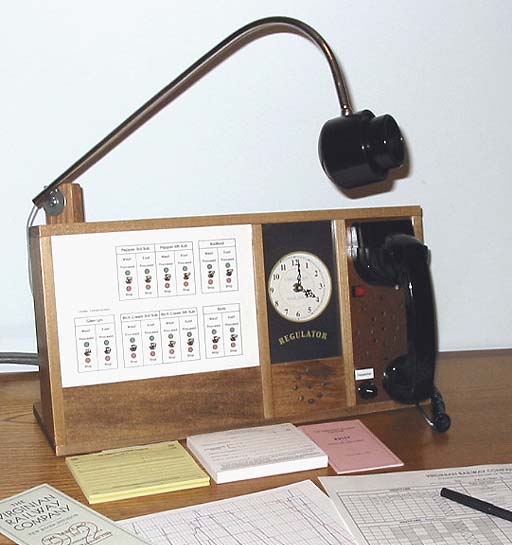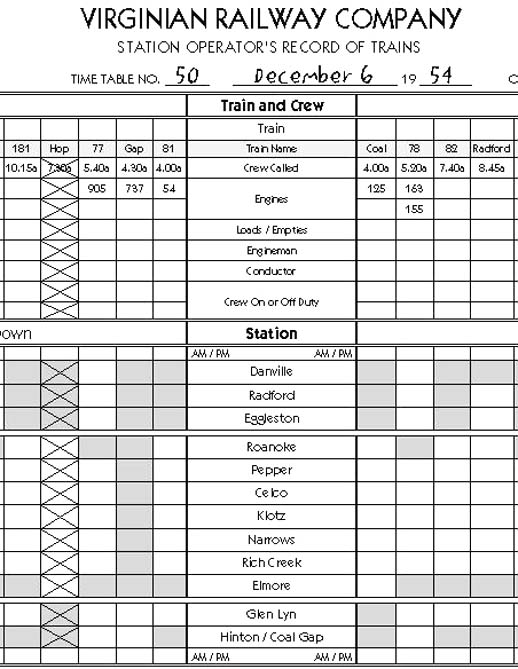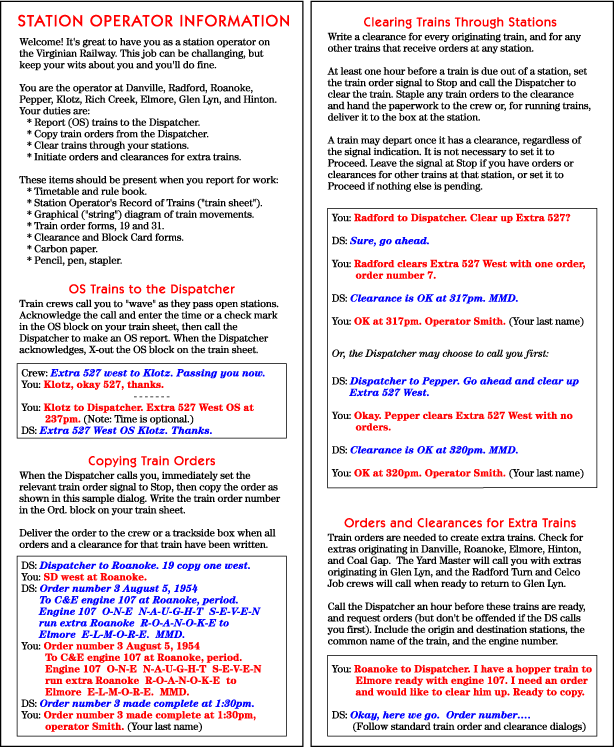On prototype railroads, the operator was the person sitting in each station, reporting trains to the Dispatcher, copying train orders, and delivering clearances and orders to the crews. But my railroad doesn't have space for nine more people sitting at desks with telephones and train order signal controls, so compromises were made.
An early compromise required train crews to assume the role of station operator and call the Dispatcher to OS when they passed open stations. This role-switching was confusing to crews and detracted from the pleasure of running the train.
Also, because there was no offical Operator position, off-duty crews were recruited as temporary operators to copy train orders from the Dispatcher. It interrupted the Dispatcher's routine each time someone new sat down - or a train order was ready and nobody was sitting there.
These issues plus comments after operating sessions convinced me that a real Station Operator was needed. This person has four duties:
- OS passing trains to the Dispatcher. This is a big improvement - crews call the Operator to say they're passing a station, then the Operator makes the OS report to the Dispatcher. In the future I may add closed-circuit television cameras at each station, and monitors for the Operator to "look through the station window" at passing trains. Then crews wouldn't have to call the Operator at all - just roll through town.
- Copy train orders from the Dispatcher and deliver them to crews. Crews come into the Operator's office and get their orders; if they're on the road, they stop their train and go get the orders. Numerous discussions with visiting crews convinced me that walking to the Operator's office from the train room is a benefit because it lengthens the run time.
- Clear trains at originating stations. The Operator checks with the Dispatcher to see if there are any more orders and, if not, writes a clearance which is OK'd by the Dispatcher. Clearances are handed to crews in the Operator's office. Realistically, clearances also should be written for trains at junctions, but after trying this I decided to stop because it created a lot of work with almost no benefits.
- Ask the Dispatcher for initial train orders for extra trains. The local yardmaster notifies the Operator when extra trains will be ready, and the Operator calls the Dispatcher. For trains originating in staging yards (no yardmaster), the Operator uses the listed departure times to decide when to call the Dispatcher.
One person plays the role of all station operators. There are nine open stations, comprising five modeled towns and four staging yards, so the Operator is a busy person. Here's the Operator's desk, ready for action.
The console has toggle switches for train order signals (red/green only; yellow is not used) at Rich Creek, Klotz, Pepper, and Radford. (If you're counting, there's an extra set of switches originally intended for Glen Lyn, but train order signals normally aren't used in yards, so this will probably never be used.)
The clock is connected to the same fast-clock circuit as the layout clocks, and runs at the same 4:1 speed.

There are two telephone systems, Communication with the Dispatcher uses a concealed wireless intercom with a microphone and loudspeaker, and a stomp-to-talk foot switch. The Dispatcher's console is similar, but has only the fast clock, microphone, loudspeaker, and foot switch.
Train crews calling in are heard through a second loudspeaker, but the Operator must pick up the telephone handset to talk with them. This works like a normal telephone; there is no foot switch. The Operator may press the red button to call the Glen Lyn Yard Master. This dings a bell and turns on a bright red light near the YM's telephone. Crews entering the east end of the yard have an identical button.
On the desk near the console are pads of clearance and train order forms, rule book, timetable, string diagram, and Operator's train sheet (see below).
This Operator's train sheet helps organize the work. Trains (including extras) are shown across the top, with normal departure times. The Train Name row holds common train names, and is most helpful for extras that don't have a number until an engine is assigned. Once that happens, the Operator writes the number in the Train column (some extras always run with the same engines, so I've pre-filled those columns).

Each open station is listed on a separate row. Blocks are shaded if a train doesn't pass through a particular station. The Station Operator enters various information in the blocks. Some Operators write train order numbers and "C" when a clearance is received. Or an "X" or time may be entered when a train is OS'ed to the Dispatcher.
This card (both sides shown) explains how to perform the Operator tasks. Sample dialogs are also included for inexperienced Operators.

